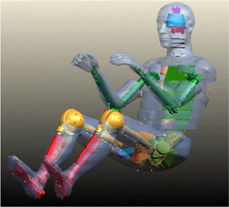 Objective
Objective
The WorldSID program is set up to develop the new, Worldwide acceptable, advanced technology, Side Impact crash test Dummy for improved assessment of injury risk to car occupants in lateral collisions. Two major motives drive the development of WorldSID. First, improved understanding of human responses in side impact will drive an enhanced dummy design, hence creating means to improve occupant protection. Second, harmonization will eliminate the use of different dummies in different areas of the world.
Industry and Government Working Together
Cooperation between industry and government is essential to the success of WorldSID. The project, initiated under the auspices of the International Organization for Standardization (ISO), is supported by automotive manufacturers, suppliers and governmental organizations around the world. A major part of the work of the EC funded program SID-2000 is being contributed to WorldSID and constant coordination with the International Harmonized Research Activity (IHRA) ensures that the dummy developed will be suitable for use in future worldwide regulatory test procedures as well as in advanced research and development work.
ISO WorldSID Task Group and Design Team
The ISO WorldSID Task Group consists of experts from industry and governments representing three regional WorldSID advisory groups: Americas, Europe and Asia/Pacific. The Task Group is chaired, in turn, by each of the chairpersons of the three regional groups. The Task Group acts on behalf of the sponsors and reports to the ISO working group on Anthropomorphic Test Devices (TC22/SC12/WG5). The ISO WorldSID Task Group has selected first concepts of the dummy parts and contracted a design team to design and build the dummy. The WorldSID Program Manager leads the design team and reports to the Task Group. Contact information for the tri-chair is given in the Work Items section.
WorldSID Design
The ISO WorldSID Task Group has created an extensive set of design and performance specifications taking into account ISO and IHRA recommendations. It is the design team’s task to use this as a baseline for the design of WorldSID. A prototype was completed in the fall of 2000. Extensive biofidelity evaluations of the prototype dummy has been conducted worldwide. The design and user specifications of the dummy at Standard Build Level-C has been released into the public domain.
WorldSID The harmonized, advanced, mid-sized male side impact dummy
- enhanced injury assessment for a new harmonized test procedure using harmonized injury risk criteria
- good to excellent biofidelity, and based on recent anthropometry data
- improved handling in positioning, calibration, instrumentation and assembly/disassembly
- well controlled dynamic behavior (durability, reproducibility, repeatability, and sensitivity)
Original Design Intent:
Head (SID-2000 FTSS Europe)
- polyurethane skull

- skin bonded to skull
- featureless face
- no split lines
- instrumentation core block
- linear and angular accel’s
- tilt sensors
Neck (SID-2000 FTSS Europe)
 central deformable element
central deformable element- bracket to adjust pre-impact orientation
- multi-directional biofidelity performance
- upper and lower neck load cells
- T1 linear accelerometer
- shroud to prevent unrealistic interactions
- tunable certification
Shoulders/Thorax/Abdomen (FTSS)
 super elastic alloy ribs (1 shoulder rib, 3 thorax ribs, 2 abdomen ribs)
super elastic alloy ribs (1 shoulder rib, 3 thorax ribs, 2 abdomen ribs)- each rib allows a lateral deflection of at least 75 mm
- horizontal rib orientation in seated posture, except shoulder rib and thorax rib #1
- central spine box with data-acquisition modules, accel’s and tilt sensors
- damping material bonded to inside of the ribs
- deflection sensor capable of handling high speed airbag interaction
Lumbar Spine (FTSS)
- non-traditional lumbar spine design for more humanlike thorax-pelvis coupling
(large shear possibility and low lateral bending stiffness) - lower lumbar spine bracket to adjust pre-impact posture
- lower lumbar spine load cell incorporated into the pelvis
Upper Legs (Denton)
 multiple load cells
multiple load cells- knee rotation sensor
- improved mass distribution
- knee design included
Lower Legs (Denton)
 upper and lower tibia and ankle load cells
upper and lower tibia and ankle load cells- accel’s optional at tibia and foot
- shoe integrated with foot
- possibly Achilles representation
Pelvis (SID-2000 FTSS Europe)
 multiple load cells for measuring load transfer and injury assessment
multiple load cells for measuring load transfer and injury assessment- linear accelerometer and tilt sensors
- new Trochanter design, improving pelvis/leg interaction
- pelvic bone girdle allows lateral deflection
Full Assembly
 anthropometry checked with world population
anthropometry checked with world population- represents mid-sized male of 76.7 kg
- automotive seated reference posture
- integrated wiring
- up to approx. 200 data channels
- full arm option (FTSS)
- in-dummy data acquisition (³ 64 channels) (DTS)
- linear and angular accel’s and tilt sensors (Endevco)
- multiple load cells as structural components (all load cells developed by RA Denton)
- neoprene type suit representing clothing and skin (FTSS)